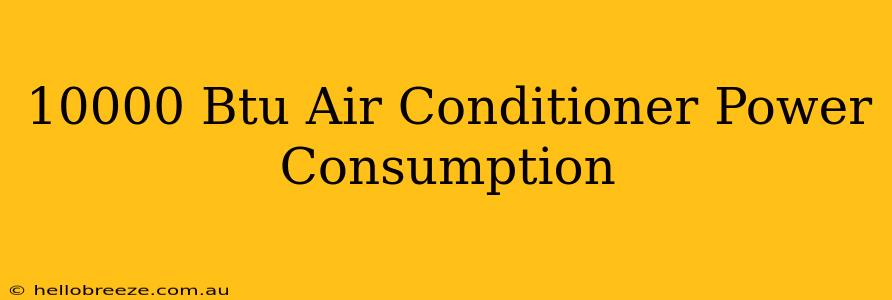Are you considering buying a 10,000 BTU air conditioner but worried about its power consumption? Understanding your air conditioner's energy usage is crucial for budgeting and making informed decisions. This comprehensive guide will delve into the power consumption of a 10,000 BTU air conditioner, helping you choose the most energy-efficient option for your needs.
Understanding BTU and Power Consumption
First, let's clarify what BTU means. BTU stands for British Thermal Unit, a measure of the cooling capacity of an air conditioner. A higher BTU rating means more powerful cooling. A 10,000 BTU unit is suitable for cooling smaller spaces, typically rooms around 300-400 square feet. However, the actual cooling power needed depends on factors such as insulation, window size, and sunlight exposure.
Power consumption, measured in watts or kilowatts (kW), indicates the rate at which the air conditioner uses electricity. A higher BTU rating generally translates to higher power consumption. Therefore, a 10,000 BTU air conditioner will consume more electricity than a smaller unit. However, the exact wattage varies greatly depending on the brand, model, and energy efficiency rating.
Factors Affecting 10000 BTU Air Conditioner Power Consumption
Several factors influence how much energy your 10,000 BTU air conditioner uses:
1. Energy Efficiency Rating (EER and SEER)
The Energy Efficiency Ratio (EER) and Seasonal Energy Efficiency Ratio (SEER) are key indicators of an air conditioner's efficiency. A higher EER and SEER rating means the unit produces more cooling per watt of electricity consumed. Look for units with high EER and SEER ratings to minimize your energy costs.
2. Inverter Technology
Air conditioners with inverter technology adjust their cooling power based on the room's temperature. This means they don't run constantly at full power, leading to lower energy consumption compared to non-inverter models.
3. Usage Habits
Your usage habits significantly affect energy consumption. Keeping the thermostat at a reasonable temperature, using fans strategically, and ensuring proper window insulation can all reduce the burden on your air conditioner and minimize power usage.
4. Ambient Temperature
Higher ambient temperatures naturally require your air conditioner to work harder, resulting in increased power consumption. This is especially true during heat waves.
5. Unit Maintenance
Regular maintenance, including cleaning the filters and coils, ensures optimal performance and reduces energy waste. A clogged filter restricts airflow, forcing the unit to work harder and consume more electricity.
Estimating Power Consumption of a 10000 BTU Air Conditioner
While the exact power consumption varies, a typical 10,000 BTU air conditioner might consume between 500 and 1,000 watts. To estimate your daily energy use, you can use the following formula:
Daily Energy Consumption (kWh) = (Wattage/1000) x Hours of Use
For example, a 700-watt air conditioner running for 8 hours daily consumes:
(700/1000) x 8 = 5.6 kWh
Multiply this by your electricity cost per kWh to determine your daily running cost.
Tips for Reducing 10000 BTU Air Conditioner Power Consumption
Here are some practical tips for minimizing your air conditioner's power usage:
- Choose a high EER/SEER rated unit: Invest in energy-efficient models to save money in the long run.
- Regularly clean the filters: Clean or replace air filters every 2-4 weeks to improve efficiency.
- Seal windows and doors: Prevent heat from entering your room.
- Use blinds or curtains: Block direct sunlight during the day.
- Use fans: Circulate air effectively and reduce the need for intense cooling.
- Set the thermostat appropriately: Avoid setting it too low.
By understanding the factors affecting power consumption and following these energy-saving tips, you can effectively manage the energy use of your 10,000 BTU air conditioner and keep your cooling costs down. Remember to always check the specifications provided by the manufacturer for the most accurate information on your specific model.

